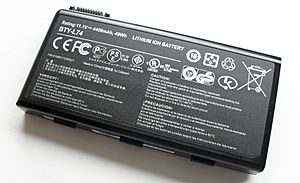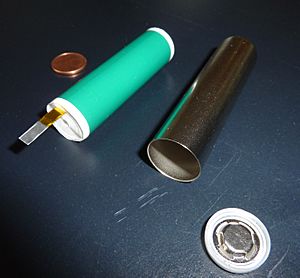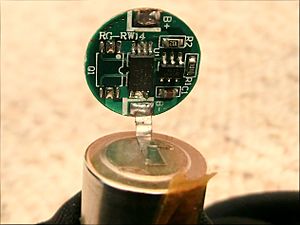Lithium-ion battery facts for kids
A lithium-ion battery is a special type of battery. It is lightweight and provides a lot of power. You can find these batteries in many devices. For example, they are used in computers and mobile phones. They often look like flat rectangles, but they come in other shapes too.
These batteries are lighter than older types, like nickel-cadmium batteries. This makes them great for portable gadgets. Lithium-ion batteries work by moving tiny lithium ions. These ions travel through a special thin sheet called a membrane.
It's important to know that lithium-ion batteries are different from regular lithium batteries. Lithium batteries have lithium metal inside and cannot be recharged. They are called primary cells. Lithium-ion batteries do not contain lithium metal. Instead, they are rechargeable, which means you can use them again and again. These are known as secondary cells. However, they don't last forever. Most lithium-ion batteries can be charged about 600 times before they start to wear out.
Contents
How Lithium-Ion Batteries Are Made
A lithium-ion battery has three main parts that make it work. These are the positive and negative electrodes, and the electrolyte. The negative electrode is usually made from carbon. The positive electrode is often a metal oxide. The electrolyte is a special liquid or gel. It contains lithium salt mixed in an organic liquid.
The electrodes change their roles depending on if the battery is charging or discharging. When you use the battery, one electrode acts as the anode and the other as the cathode. When you charge it, their roles switch.
The most common material for the negative electrode is graphite. For the positive electrode, there are a few choices. Some common ones include lithium cobalt oxide, lithium iron phosphate, or lithium manganese oxide. Scientists are also exploring new materials like graphene for electrodes.
The electrolyte is usually a mix of organic liquids. These liquids help the lithium ions move around inside the battery. The materials chosen for these parts greatly affect the battery's performance. They can change how much voltage it has, how much energy it stores, how long it lasts, and how safe it is.
Pure lithium is very reactive. It reacts strongly with water. Because of this, lithium-ion batteries use a special electrolyte that doesn't contain water. They are also sealed tightly to keep moisture out.
Lithium-ion batteries are more expensive than older types like NiCd batteries. But they work well in a wider range of temperatures. They also store more energy for their size. These batteries need special protective circuits. These circuits help control the voltage and keep the battery safe.
For devices like laptops, lithium-ion batteries come in a battery pack. This pack includes sensors to check temperature. It also has circuits to manage voltage and monitor how much charge is left. These parts help prevent problems like short circuits. They make sure each battery cell works safely.
Different Shapes of Lithium-Ion Batteries

Lithium-ion cells come in several different shapes. These shapes can be grouped into four main types:
- Small cylindrical: These are solid, tube-shaped cells. They don't have separate terminals sticking out. Older laptop batteries often used these.
- Large cylindrical: These are also solid and tube-shaped. But they have bigger screw-on terminals.
- Pouch: These cells are soft and flat. They look like small pouches. You can find them in cell phones and newer laptops. They are sometimes called lithium polymer batteries.
- Prismatic: These cells have a semi-hard plastic case. They have large screw-on terminals. They are often used in electric vehicles.
Cylindrical cells are made in a unique way. They are like a "swiss roll" or "jelly roll." A long strip of positive electrode, a separator, a negative electrode, and another separator are rolled up together. One small problem with this design is that it can have higher electrical resistance.
Pouch cells don't have a hard case. This means they can store the most energy for their weight. However, they often need an outer container. This helps stop them from expanding when fully charged. It also helps keep the battery pack stable.
In 2014, Panasonic made the smallest lithium-ion battery. It is shaped like a pin. It is only 3.5 millimeters wide and weighs just 0.6 grams.
Images for kids
See also
 In Spanish: Batería de ion de litio para niños
In Spanish: Batería de ion de litio para niños






